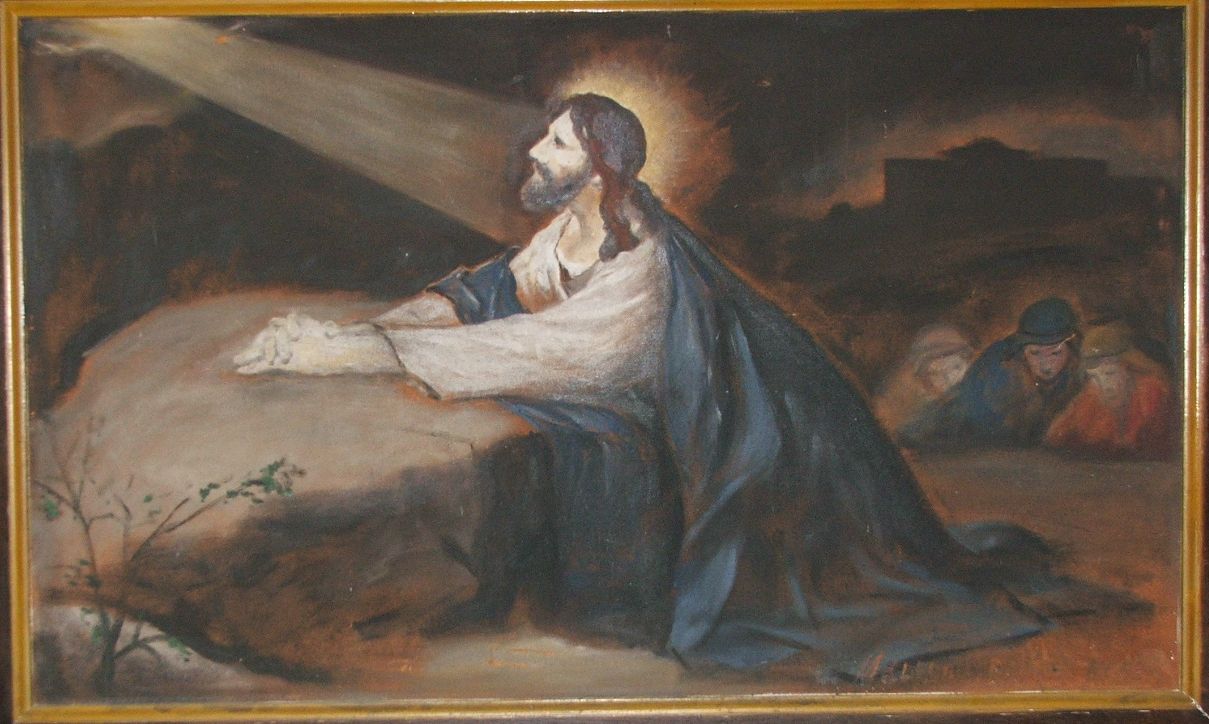What's with that painting?
By Marilyn Kettering Badger
January 11, 2016Above the double doors as you exit the sanctuary is a painting of Christ praying on a rock assumed to depict the Garden of Gethsemane. This painting hung at the front of the old sanctuary, then in the downstairs fellowship hall and now is in a sanctuary setting again. It is believed to have been painted in the 1930’s by Medford Neher who was the evangelist for a two-week meeting
Medford Neher was born July 25, 1892, in Radnor, near Flora, in Carroll County, Indiana. His parents were George W. and Priscilla (Cripe) Neher. He married Ada May Shank on September 3, 1919 and they had five children – Evelyn, Leonardo, Geneva, Phyllis, and Gwendolen.
Medford taught grade school after high school and then took his advanced schooling at Manchester College. His training for his artwork began at Manchester College in 1914 with Mrs. Sadie Stutsman Wampler. In his second year at Manchester he received a letter from the Walnut Church stating that they had called him to the ministry. Since 1914 he has served in the ministry of the church. He was ordained to the eldership in 1928. So Medford left Manchester and headed to Bethany Bible School. At Bethany Medford drew a picture to illustrate a lesson. The professor turned to Medford and almost shouted, “Young man, go be an artist.” Encouraged by the professor, A. C. Wieand, Medford enrolled in the Chicago Art Institute. About this time, under the guidance and inspiration of A. C. Wieand, he illustrated the Sunday School texts, “Foundation Truths,” and the “Life of Christ,” 1916-1917.
Medford shares, “I had my art training and was a minister but at that time our church paid neither the preacher nor the artist.” So he worked as a sign painter in Akron, Ohio. He studied with noted painters of Cleveland and Akron, Ohio. Nearly a hundred children lived on his street. He started a mission Sunday School and church in his front yard that was an instant success and developed into the Eastwood Church of the Brethren. Later he held many two-week long evangelistic meetings. He would preach the meetings and paint a large religious painting to leave with the church. Thus he left more than 100 paintings in churches in the eastern United States and Puerto Rico. When he could no longer stand being away from his family so long, he accepted the call to serve a pastorate in Northwestern Ohio, the first of a number of pastorates in Ohio, Illinois and Florida. The following churches have been served by this good family - Akron Eastwood in Northeast OH; Defiance and North Poplar Ridge in Northwest OH; Peoria in Southern IL, Michigan City, IN, Springfield in IL, and Pompano Beach in FL.
He had a dream of painting the history of the Church of the Brethren starting in 1708. The youth of the region took up the idea and challenged him to do it with their support and encouragement. The “Murals at Camp Mack”, Indiana’s COB camp, were painted while he was serving the Poplar Ridge Church in Northwestern Ohio. He worked for the church part time and did the paintings in northern Indiana at the Camp part time. The average size of the murals is five and a half feet by fifteen feet. They are mounted six to a side on opposite sides of the auditorium. Because the stonewalls at each end were constructed first and are not exactly parallel, the two sides of the building are not of equal length. This resulted in Panel Four being shortened by cutting an irregular pattern out of the mural to fit between the two steel columns erected closer to each other than the others. A theme throughout the panels shows white wings at the top. Depending upon the time period, the wings vary from bright white to dark cloud or smoke covered. There is much symbolism throughout the murals. People to the front are actual people in the Church of the Brethren history. Less defined figures farther back, represent peoples of history not specific persons, as do the shadows of the times, buildings, historical happenings.
His work as an artist has always been his delight and avocation. He has painted many pictures for churches and has done a portrait of his friend and teacher, Dr. A. C. Wieand for Bethany Biblical Seminary as well as the 12 murals at Quinter-Miller Auditorium at Camp Alexander Mack, Milford, Indiana and the many paintings in church where he preached. Maple Grove’s is blessed to have one of these. Medford Neher passed away in 1983.


